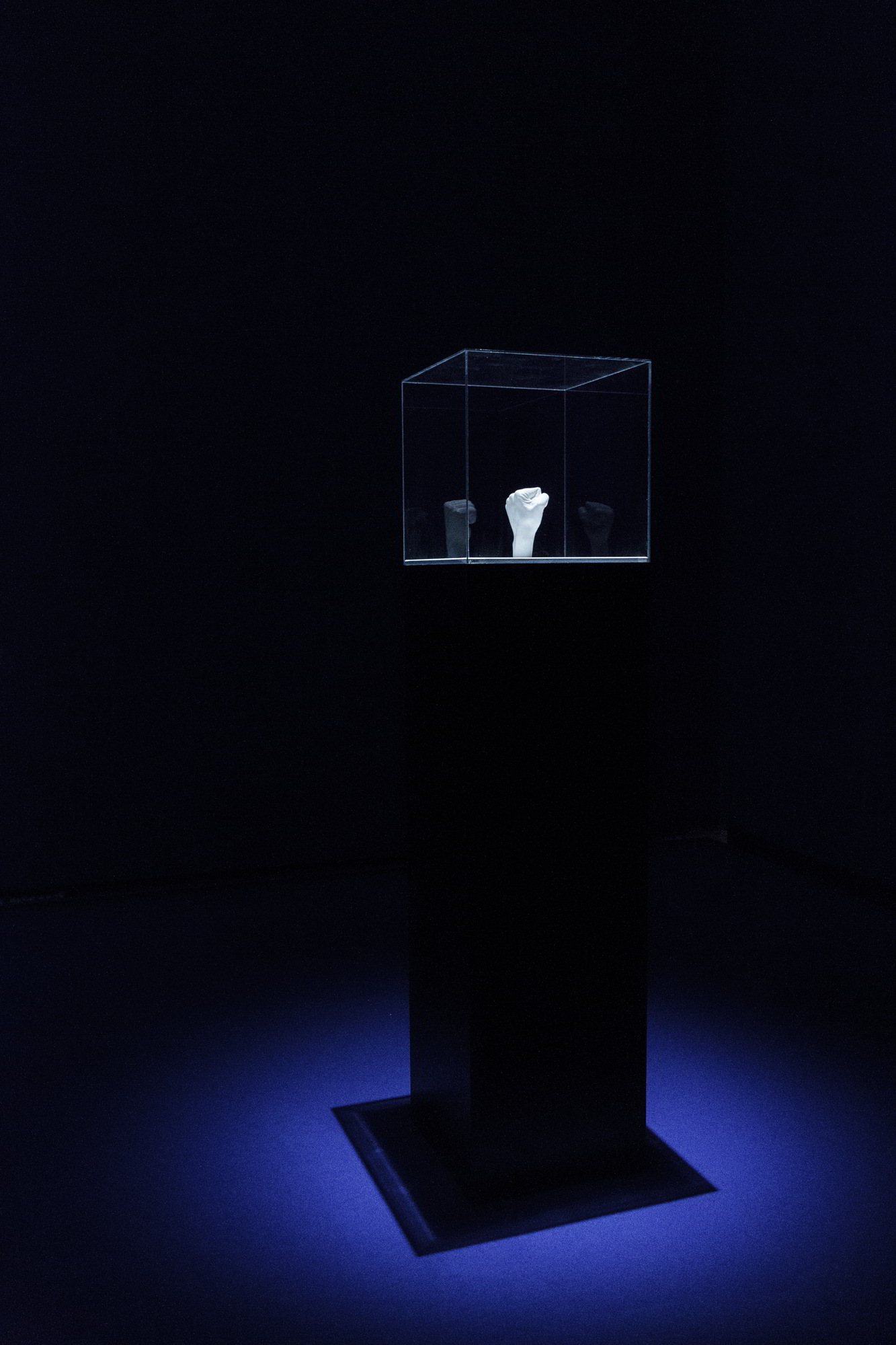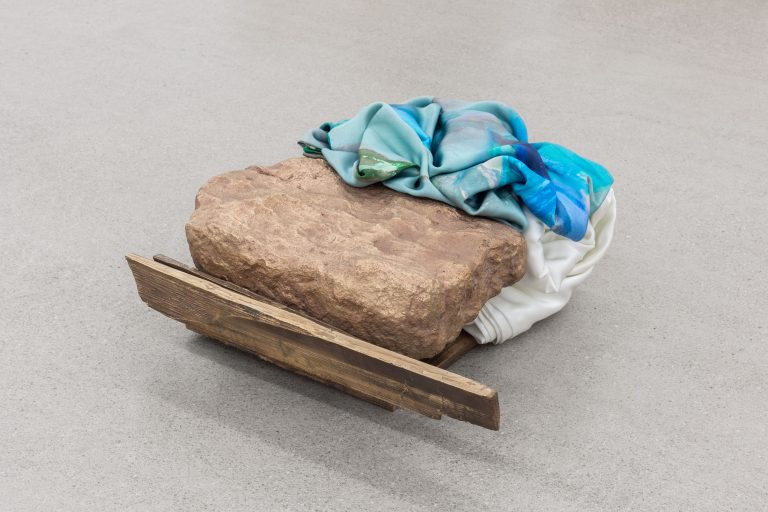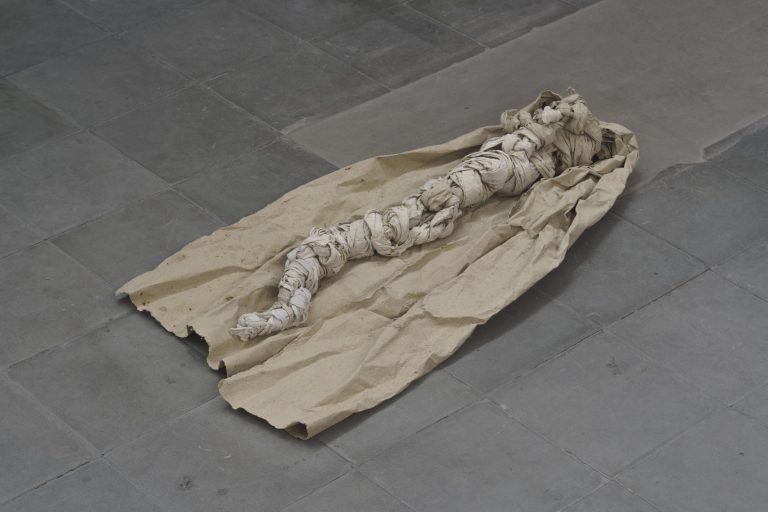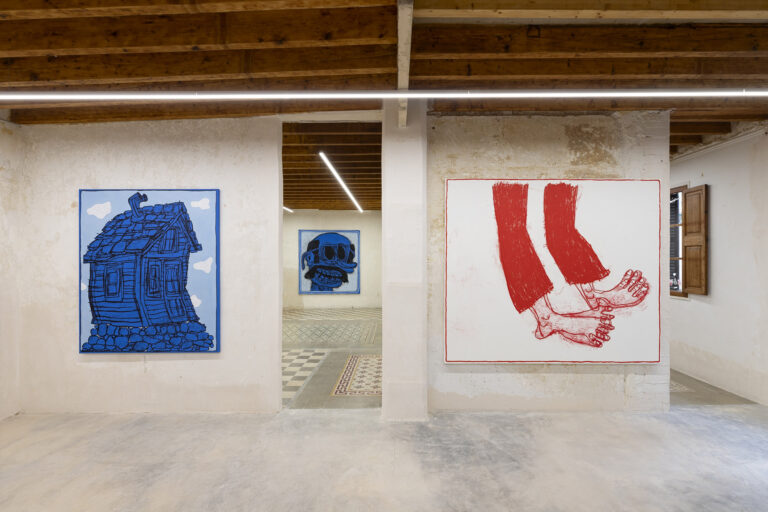Artist: Itziar Barrio
Exhibition title: By All Means
Curated by: Johanna Burton
Venue: Azkuna Zentroa, Bilbao, Spain
Date: January 28 – April 8, 2018
Photography: all images copyright and courtesy of the artist and Azkuna Zentroa
Note: Exhibition booklet can be found here
Azkuna Zentroa presents from February 15th to May 6th 2018 the exhibition of Itziar Barrio BY ALL MEANS curated by Johanna Burton. This show is the artist’s first major survey that brings together her work over the last decade.
Human beings relate to one another through a variety of modes of exchange, and via all matter of means: language, money, emotions, politics, symbols, family, community, geography, technology, and sex (to name just a few). Itziar Barrio explores these and other ways that we navigate the world and each other, and points to what unites them all—power. Barrio’s interest in the nature of social negotiation manifests in live performance, video, photography, sculpture, and expanded installation techniques. /
‘ When I was first introduced to Itziar Barrio’s work, about two years ago, it was within the context of a show she mounted at Participant Inc., an important alternative space in New York City run by the curator Lia Gangitano. The show, THE PERILS OF OBEDIENCE (May 25—June 19, 2016), was a stop along the way of a multi-part, multi-city project that had begun in Bilbao in 2010, and was making its long way towards a conclusion. One important chapter of the project was staged at Participant Inc. Another is happening here, in Bilbao as part of Barrio’s survey at the Azkuna Zentroa. It is crucial, in encountering Barrio’s work, to recognize that much of it operates this way: episodically and over both time and space. To see the artist’s work is often to see only part of it, or, put another way, to see it as it unfolds.
We are not always accustomed to understanding projects in museums this way. Indeed, part of the pleasure-but also the challenge—of curating this exhibition has been working to make visible the expanded frameworks necessary to the various projects and artworks included. To say so is only to echo Barrio’s own desires as an artist. She has, for as long as she has been making art, aimed to present things not as they are but as they have come to be. Barrio’s interest in, for example, highlighting the technological mechanisms of film and other narrative structures gives a clear example of her desire to include in any picture what is usually simply understood as the means to produce it.
Means. It’s a word with many definitions, and we hope to conjure them all with the title of this show. Significantly, means are resources, usually financial; relatedly, they are also understood as what might be required to attain a desired end. Differently, a ‘mean’ is the middle-point between two extremes. As a verb it has to do with signification. As an adjective it points to the opposite of kindness. Finally, in English, there is an idiom, which translates more or less to both Spanish and Basque: BY ALL MEANS. This is a phrase one uses to affirm a commitment, to indicate that one is all in, without a doubt. It also alludes to the material and ideological sacrifices one must make in order to honor such commitments.
Barrio’s work takes up aspects of social contracts—and the means at stake within them—in every project to date. Her explorations into a wide range of cultural production are so many case studies of how we understand ourselves and other as actors within a network of ongoing script. Unflinchingly addressing the deep entanglement between power and seduction, Barrio’s work point to the ways in which gender, race, sexuality, labor, desire, and more are the subtext of all negotiations, whether political or personal. Yet, rather than simply victims of circumstance, we may work to write, rewrite, or reroute the stories in which we play a part, whether small or large. So, while experiencing BY ALL MEANS, remember that, yes, this is an exhibition, but it’s also just one moment in a much longer, ever-evolving plot. ’
Johanna Burton, Curator
Keith Haring Director and Curator of Education and Public Engagement. New Museum, New York
ALL OF US WANT TO WORK LESS
Like many of Barrio’s projects, ALL OF US WANT TO WORK LESS takes multiple forms (performance, video, and sculptures) and is ongoing. At stake in its distinct iterations are questions revolving around labor and the value of different kinds of work.
In a performance executed in 2015 at MACBA in Barcelona (a version of which will be performed at the Azkuna Zentroa on May 4), Barrio appropriates an infamous scene from the 1992 film ‘Basic Instinct’. Rather than a panty-less Sharon Stone, however, Barrio’s actor is both clothed and male. He also breaks from the original script by engaging in producing a cement sculpture that hardens over the duration of his performance. Reciting Stone’s lines, interspersed with lines of text borrowed from other sources, he calls attention to the artifice and mechanisms of all production (as well as the ways in which it is always inflected by gender, race, and class).
Similarly, in a 2015 video also titled ALL OF US WANT TO WORK LESS, two actors riff off Robert Bresson’s 1959 feature film, ‘Pickpocket’. A pointed critique of labor policies and conditions, Barrio’s piece ironically shows that even stealing requires a precise skill-set and lots of practice if one is to succeed at it.
Itziar Barrio, All Of Us Want To Work Less, 2018, exhibition view, Azkuna Zentroa, Bilbao
Itziar Barrio, All Of Us Want To Work Less, 2018, exhibition view, Azkuna Zentroa, Bilbao
Itziar Barrio, All Of Us Want To Work Less, 2018, exhibition view, Azkuna Zentroa, Bilbao
Itziar Barrio, All Of Us Want To Work Less, 2018
Itziar Barrio, All Of Us Want To Work Less, 2018
Itziar Barrio, All Of Us Want To Work Less, 2018
Itziar Barrio, All Of Us Want To Work Less, 2018
Itziar Barrio, All Of Us Want To Work Less, 2018, exhibition view, Azkuna Zentroa, Bilbao
Itziar Barrio, All Of Us Want To Work Less, 2018, exhibition view, Azkuna Zentroa, Bilbao
Itziar Barrio, All Of Us Want To Work Less, 2018, exhibition view, Azkuna Zentroa, Bilbao
Itziar Barrio, All Of Us Want To Work Less, 2018, exhibition view, Azkuna Zentroa, Bilbao
Itziar Barrio, All Of Us Want To Work Less, 2018, exhibition view, Azkuna Zentroa, Bilbao
Itziar Barrio, All Of Us Want To Work Less, 2018, exhibition view, Azkuna Zentroa, Bilbao
Itziar Barrio, All Of Us Want To Work Less, 2018, exhibition view, Azkuna Zentroa, Bilbao
Itziar Barrio, All Of Us Want To Work Less, 2018, exhibition view, Azkuna Zentroa, Bilbao
Itziar Barrio, All Of Us Want To Work Less, 2018, exhibition view, Azkuna Zentroa, Bilbao
Itziar Barrio, All Of Us Want To Work Less, 2018, exhibition view, Azkuna Zentroa, Bilbao
THE PERILS OF OBEDIENCE
Barrio’s ambitious multi-platform, multi-site work, THE PERILS OF OBEDIENCE, is an ongoing exploration into the mechanics of power. Exploring the every day scripts and roles we adhere to or resist, Barrio utilizes recognizable tropes from TV, theatre, and film to call upon shared behaviour and references. In 1961, Stanley Milgram commenced experiments meant to shed light on the acts of genocide committed by the Nazis during World War II. Milgram’s findings pointed to hierarchies of power, and he argued that, when acting under the sanctioned authority of another, most people would, in fact, go to the ultimate extremes to follow orders.
Following Milgram, Barrio nonetheless suggests that there are alternatives to structural oppression, if only through recognizing the pervasiveness of its terms. Through open rehearsals, highjacked mash-ups of appropriated scripts, and blurred lines between characters and ‘authentic’ selves, ‘Perils’ locates negotiations of power firmly in social contracts rather than the individuals embedded in them. Barrio’s utilization of the technological (laying bare the means of production of film, for instance) and the manual (via highly tactile sculptures and other objects that are part of the larger project) create vibrant scenes in which an audience also plays a large part. In encountering Barrio’s work, viewers become part of—and thereby help shape—its next chapter.
Itziar Barrio, The Perils Of Obedience, 2018, exhibition view, Azkuna Zentroa, Bilbao
Itziar Barrio, There Is Nothing To Be Scared Of. They Are Crazy About Each Other (Excerpts), 2018
Itziar Barrio, The Perils Of Obedience, 2018, exhibition view, Azkuna Zentroa, Bilbao
Itziar Barrio, There Is Nothing To Be Scared Of. They Are Crazy About Each Other (still), 2018
Itziar Barrio, There Is Nothing To Be Scared Of. They Are Crazy About Each Other (still), 2018
Itziar Barrio, There Is Nothing To Be Scared Of. They Are Crazy About Each Other (still), 2018
Itziar Barrio, The Perils Of Obedience, 2018, exhibition view, Azkuna Zentroa, Bilbao
Itziar Barrio, The Music You Want Me To Hear, 2018
Itziar Barrio, The Music You Want Me To Hear, 2018
Itziar Barrio, The Perils Of Obedience, 2018, exhibition view, Azkuna Zentroa, Bilbao
Itziar Barrio, The Perils Of Obedience, 2018, exhibition view, Azkuna Zentroa, Bilbao
Itziar Barrio, The Perils Of Obedience, 2018, exhibition view, Azkuna Zentroa, Bilbao
Itziar Barrio, The Perils Of Obedience, 2018, exhibition view, Azkuna Zentroa, Bilbao
Itziar Barrio, The Perils Of Obedience, 2018, exhibition view, Azkuna Zentroa, Bilbao
Itziar Barrio, The Perils Of Obedience, 2018, exhibition view, Azkuna Zentroa, Bilbao
Itziar Barrio, The Perils Of Obedience, 2018, exhibition view, Azkuna Zentroa, Bilbao
Itziar Barrio, The Perils Of Obedience, 2018, exhibition view, Azkuna Zentroa, Bilbao
Itziar Barrio, The Perils Of Obedience, 2018
THE HISTORY OF THE FIST
THE HISTORY OF THE FIST, Barrio’s investigation of the deeply symbolic gesture of the human hand clenched and raised, takes viewers on a journey one part historical and another speculative. Acknowledging the pervasive readings that usually attend any such case study, Barrio shows how easily any single meaning can multiply. Indeed, in the settings by which she frames the fist—cave, strip club, and lab—the artist points as well to the ways in which cultural conventions are able to hold competing, even contradictory, connotations. Barrio’s assemblage of images, speakers, and texts in THE HISTORY OF THE FIST delivers an unstable portrait of an ostensibly universal icon.
The fist, as we see, continues to hold as a recognizable mark of revolution, resistance, and solidarity. Yet without any specific context, severed from its moment, it stands also as a generic sign, quite literally a rebel without a cause. In allowing for this disconnect, Barrio insists on recentering histories of struggle for women and people of color in particular. In addition, she imagines new meanings by which the fist can be utilized, calling upon the sexual nature of the hand, for instance, and pointing to evidence that suggests the earliest cave paintings were in fact executed by women. Barrio’s narrative of an icon weaves it—and us—through time and space, fact and fiction, individual and collective meaning.
Itziar Barrio, The History Of The Fist, 2018, exhibition view, exhibition view, Azkuna Zentroa, Bilbao
Itziar Barrio, The History Of The Fist, 2018
Itziar Barrio, The History Of The Fist, 2018, exhibition view, exhibition view, Azkuna Zentroa, Bilbao
Itziar Barrio, The History Of The Fist, 2018, exhibition view, exhibition view, Azkuna Zentroa, Bilbao
Itziar Barrio, The History Of The Fist, 2018
Itziar Barrio, The History Of The Fist, 2018
Itziar Barrio, The History Of The Fist, 2018, exhibition view, exhibition view, Azkuna Zentroa, Bilbao
Itziar Barrio, The History Of The Fist, 2018, exhibition view, exhibition view, Azkuna Zentroa, Bilbao
WE COULD HAVE HAD IT ALL
In WE COULD HAVE HAD IT ALL, Barrio investigates overlaps between private and public desire. Utilizing Adele’s 2011 mega-hit, ‘Rolling In The Deep’, the artist asks that audiences consider language as a material object.
Set in Bilbao’s lush Teatro Arriaga, Barrio’s video tracks the contours of a space dedicated to highlighting the architecture of performance. Here we see empty seats faced uni-directionally, their aim to best position a collective group to receive sound, image, and words. Yet, in emptying the theatre and making the drama of her video about the space but the space itself rather than anything unfolding within it, Barrio displaces our expectations. In addition, Adele’s score is delivered without the star’s now iconic voice. Rather, we receive her lyrics as words to be read; they are subtitles for a scene that both unfolds and never begins. Layers of meaning are added by way of spoken and written word by two more women -Maialen Lujanbio, a Basque poet whose bertsolarismo challenges and reroutes Adele’s clichéd script, and Chavisa Woods, an American poet who tellingly conflates sexual and political awakening. The two poets engage one another, and the absent Adele, giving new texture not only to a set of pop lyrics, but to the very possibilities of spectatorship.
Itziar Barrio, We Could Have Had It All, 2018, exhibition view, exhibition view, Azkuna Zentroa, Bilbao
Itziar Barrio, We Could Have Had It All, 2018
Itziar Barrio, We Could Have Had It All, 2018, exhibition view, exhibition view, Azkuna Zentroa, Bilbao
Itziar Barrio, We Could Have Had It All, 2018
Itziar Barrio, We Could Have Had It All, 2018
Itziar Barrio, We Could Have Had It All, 2018
Itziar Barrio, We Could Have Had It All, 2018, exhibition view, exhibition view, Azkuna Zentroa, Bilbao
Itziar Barrio, We Could Have Had It All, 2018, exhibition view, exhibition view, Azkuna Zentroa, Bilbao
Itziar Barrio, We Could Have Had It All, 2018, exhibition view, exhibition view, Azkuna Zentroa, Bilbao
Itziar Barrio, We Could Have Had It All, 2018, exhibition view, exhibition view, Azkuna Zentroa, Bilbao
Itziar Barrio, We Could Have Had It All, 2018, exhibition view, exhibition view, Azkuna Zentroa, Bilbao























































